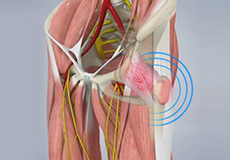Danielle DeGiorgio DO, FAAPMR

The hip is more than a simple ball and socket joint. With more than 20 muscles spanning the joint and variation of the bony anatomy, maintaining balanced forces of the hip can be arduous.
This article will discuss one of the more common hip injuries of the adolescent athlete, “snapping hip syndrome”.
Snapping hip syndrome is named for the sound or feel of a catching tendon across the hip joint. It is most common in gymnasts, soccer players, runners and rowers between the ages of 15-35 years old. There are two main types: Internal and External.
Internal snapping hip syndrome can be caused by intraarticular causes (such as a labral tear), but is more commonly caused by iliopsoas (hip flexor) tendon rubbing over the pelvic bone. This leads to an audible “snap” in the groin area. It may initially be painless, but may become more painful with frequent occurrence.
External snapping hip syndrome is caused by the fibrous “IT” (iliotibial band) rubbing over the outer side of the thigh bone (femur). On occasion, athletes may describe the hip as “popping” out of the socket due to visual deflection of the muscle and audible pop. Given the force needed to dislocate the hip, this is highly unlikely. However, left untreated snapping hip syndrome can progress to more severe symptoms including tendonitis/bursitis.
Snapping hip syndrome is common in adolescent athletes, during or immediately following a growth spurt. This is because their bones grow faster than musculature allows, leading to tight muscle groups.
Most internal/external causes of snapping hip syndrome can be treated from a conservative/non-surgical perspective. This can include modalities such as massage, stretching/strengthening including core/gluteal musculature, and at times physical therapy. However prompt evaluation by a sports medicine physician is advised as prolonged symptoms left untreated may lead to decrease in athletic performance and further injury.
Patients may return to full athletic activity once they demonstrate full painless range of motion, strength and function. These athletes will benefit from a daily stretching program to prevent recurrence of injury, which can be demonstrated by their sports medicine physician.


